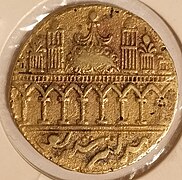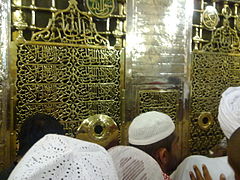Green Dome
| Green Dome | |
|---|---|
Al-Qubbah Al-Khaḍrāʾ (ٱَلْقُبَّة ٱلْخَضْرَاء) | |
Al Mansur Qalawun[1] | |
| Date established | 678 A.H. / 1279 C.E.[2][1] |
| Completed | 678 A.H. / 1279 C.E.[2][1] |
| Materials | Wood,[3] brick[4] |
The Green Dome (
The structure dates back to 1279 C.E., when an unpainted wooden cupola was built over the tomb. It was later rebuilt and painted using different colours (blue and silver) twice in the late 15th century and once in 1817. The dome was first painted green in 1837, and hence became known as the "Green Dome".[2]
History

Built in 1279 C.E. or 678
When
Tomb of Muhammad and early caliphs
Muhammad's grave lies within the confines of what used to be his and his wife Aisha's house, during the Hijra. During his lifetime, it adjoined the mosque. The first and second Rashidun Caliphs, Abu Bakr and Umar are buried next to Muhammad. Umar was given a spot next to Abu Bakr by Aisha, originally intended for her. The mosque was expanded during the reign of Umayyad Caliph al-Walid I to include their tombs.[2] The graves themselves cannot be seen, as a gold mesh and black curtains cordon off the area.[12]
The graves and what remains of Aisha's house are enclosed by a 5-sided wall, without doors or windows, built by the caliph
Panorama

Gallery
-
View from the western side of the Hujra
-
17th century bronze coin depicting Mamluk era dome which preceded the current dome
-
The Green Dome, in Burton's Pilgrimage, c. 1850 CE
-
The Dome, first photographed in 1880 by Muhammad Sadiq
-
The grave of Muhammad located inside the quarter seen here
See also
- Bayt al-Mawlid, the housewhere Muhammad is believed to have been born
- Burial places of founders of world religions
- Destruction of early Islamic heritage sites in Saudi Arabia
References
- ^ a b c d "Prophet's Mosque". ArchNet. Archived from the original on 23 March 2012. Retrieved 13 April 2012.
- ^ ISBN 978-9835203732.
- ^ a b "The history of Green Dome in Madinah and its ruling". Peace Propagation Center. 4 June 2009. Archived from the original on 24 August 2011. Retrieved 13 April 2012.
- ^ a b Meinecke, Michael (1993). Mamlukische Architektur (in German). Vol. 2. pp. 396–442.
- ^ ISBN 978-0203203873.
- ISBN 9004127569.
- ISBN 978-0470182574.
- ISBN 978-0470182574.
- ISBN 978-0275987343.
- ISBN 978-0807855775.
- ^ "Kya gumbad e Khazra ko gira dena chahye Reply to Bol TV Ulamaa | Engineer Muhammad Ali Mirza". www.youtube.com. Retrieved 13 December 2020 – via YouTube.
- ^ "Important Sites: The Prophet's Mosque". Inside Islam. 16 February 2012. Retrieved 13 August 2018.





